Peru Tourism And Attractions offer a captivating blend of history, culture, and natural beauty that appeals to a wide range of travelers. Let SIXT.VN be your guide to unlocking the wonders of Peru, offering seamless travel solutions from airport transfers to curated tours, ensuring an unforgettable journey. Explore Peru’s iconic landmarks, cultural richness, and breathtaking vistas, creating memories that last a lifetime with convenient travel packages.
1. Discovering Machu Picchu: The Lost City of the Incas
Is Machu Picchu worth visiting? Absolutely! Machu Picchu is one of the most magical settings of a ruined city anywhere in the world. Perched high upon a ridge, 300 meters above the Urubamba River, the majestic Inca City of Machu Picchu stands as a testament to the ingenuity and architectural prowess of the Inca civilization. Almost as impressive as the ruins themselves is the spectacular backdrop of steep, lush, and often cloud-shrouded mountains. Standing near the caretaker’s hut, looking out over Machu Picchu, the jungle-covered mountains, and the river far below, you can imagine why the Incas chose this place to build their city.
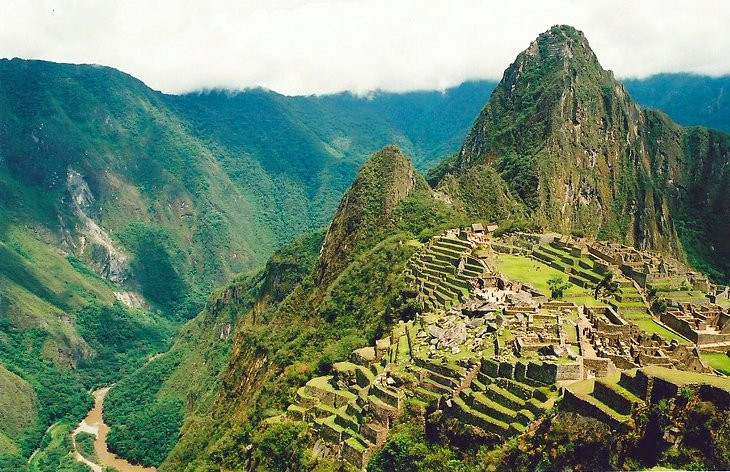 Machu Picchu – Inca City nestled in the Andes Mountains
Machu Picchu – Inca City nestled in the Andes Mountains
Hiram Bingham came across Machu Picchu in 1911 and believed until his death that it was the “Lost City of the Incas,” first documented by Spanish soldiers in the 1500s. However, historians believe the real lost city of the Incas was at Espíritu Pampa, a ruin Bingham knew of but discounted as being insignificant.
The journey is also part of the experience of visiting Machu Picchu, whether it’s by hiking the Inca Trail or seeing the route by train. In either case, it’s impossible not to be inspired by the scenery. Trains leave from Cusco, Ollantaytambo, or Urubamba to Aguas Calientes.
From Aguas Calientes, the town below Machu Picchu, a bus takes you up to Machu Picchu, about a 20-minute drive along a harrowing switchback road. It is possible to walk up this road to the site, but this is a long, uphill climb and not recommended.
The admission rules are that you must tour with a guide, you must follow a set tour route. You also have to enter the park at a designated time. Be aware that many websites say they sell tickets, but be sure to go to the official site.
The high season is June to August, but the two months on either side of this also see decent weather and can be a good time to visit with fewer crowds.
According to the Peruvian Ministry of Culture, Machu Picchu receives over 1.5 million visitors annually, highlighting its global appeal. Planning your visit with SIXT.VN ensures you have a seamless experience, from transportation to accommodations, allowing you to fully immerse yourself in the awe-inspiring atmosphere of this ancient wonder.
2. Hiking the Inca Trail: An Unforgettable Journey
What is the Inca Trail known for? The Inca Trail is famous for its stunning scenery and historical significance. The famous Inca Trail is a four-day hike, which terminates at Machu Picchu and is regarded by many as the highlight of their trip to Peru. This scenic trail is often more demanding than what many people are expecting, but it’s also rewarding and one of the most popular things to do in Peru.
A couple of different starting points for the Inca Trail exist, but the traditional four-day hike begins at km 82 of the Cusco – Aguas Calientes rail line. From this point, the trail passes more than 30 Inca ruins and traverses through spectacular scenery. The most difficult portion of the trail is the second day of the hike, with a climb of 1,200 meters in elevation gain and two high passes.
The hike must be done with an agency, and reservations should be booked well in advance, particularly in the high season of June to August.
Some agencies offer a shorter version of the hike, which entails either the last two days or just the last day of the hike. There are campgrounds at intervals along the trail and one at the base of Machu Picchu.
Depending on the type of tour, hikers can either carry their own backpack or have it transported for them. The daily number of hikers and porters on the trail is strictly enforced.
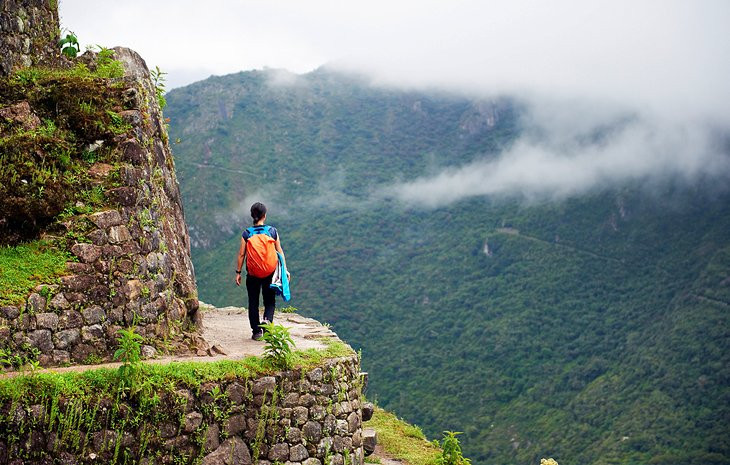 Inca Trail – Winding path through lush mountains
Inca Trail – Winding path through lush mountains
According to research from the Ministry of Tourism of Peru, the Inca Trail sees approximately 25,000 hikers each year, necessitating permits booked well in advance. SIXT.VN can assist you in securing permits and arranging guided tours, ensuring a safe and enriching trekking experience through the Andes.
3. Exploring Cusco’s Architectural Treasures: A City of History
Why is Cusco such a popular tourist destination? Cusco is a popular tourist destination because of its rich history, stunning architecture, and proximity to Machu Picchu. Walking through the streets of Cusco is like wandering through a museum, with history built upon history in this UNESCO World Heritage Site. Inca ruins have been used in the foundations of many of the lovely old colonial buildings lining the narrow roads, showcasing the city’s long history.
The main square, Plaza de Armas, in the city center is home to the Cathedral and La Compania, two equally impressive structures. The square is also a great place to start a walking tour, grab a meal, or people watch during the day.
And while there are countless buildings and museums worth visiting, the church of Santo Domingo, resting on the ruins of the Inca site of Coricancha, is one of Cusco’s must-see attractions.
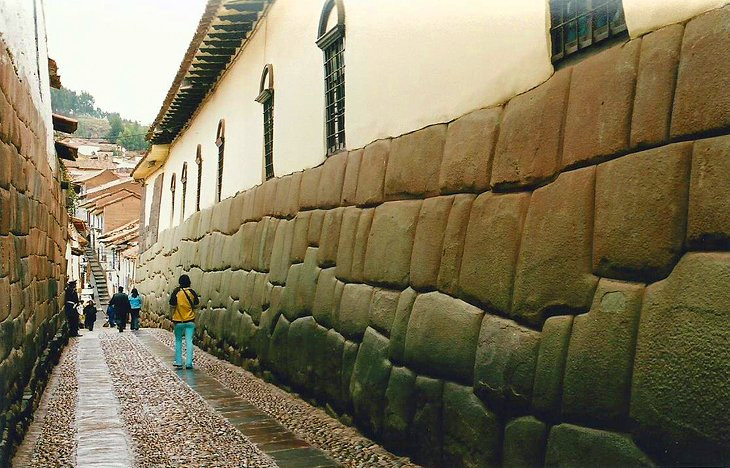 Cusco – Inca wall with colonial architecture above
Cusco – Inca wall with colonial architecture above
According to UNESCO, Cusco was declared a World Heritage Site in 1983, recognizing its significance as a historical and cultural landmark. With SIXT.VN, explore Cusco’s architectural treasures with ease, utilizing our reliable transportation services to discover hidden gems and iconic sites within this ancient city.
4. Cruising Lake Titicaca: The Highest Navigable Lake
What makes Lake Titicaca so special? Lake Titicaca is special because it is the highest navigable lake in the world and home to unique floating islands. The sparkling blue water of Lake Titicaca is surrounded by rolling hills and traditional small villages. The lake area is a mix of beautiful scenery and culture that sets it apart from other regions of the country. Sitting at 3,820 meters above sea level, Lake Titicaca is known for being the highest navigable lake in the world.
A boat trip to the islands and surrounding villages is the best way to appreciate the lake. One of the main tourist attractions is the Uros Floating Islands (Islas Flotantes), which sustain small communities of Uros Indians. These are man-made islands constructed of reeds that have sustained a traditional way of life since the time of the Incas.
What you’ll see on tours to these islands is designed for tourism, but it does offer a glimpse into a traditional way of life. The floating islands are only one very small part of Lake Titicaca’s attraction, with the real charm lying in the small villages in the hills along the shores of Titicaca and on the main islands of Isla Taquile and Isla Amantani.
The main gateway to Lake Titicaca is the city of Puno, where you’ll find hotels, restaurants, and travel agencies. There are trains and buses to Puno and flights in and out of the nearby city of Juliaca.
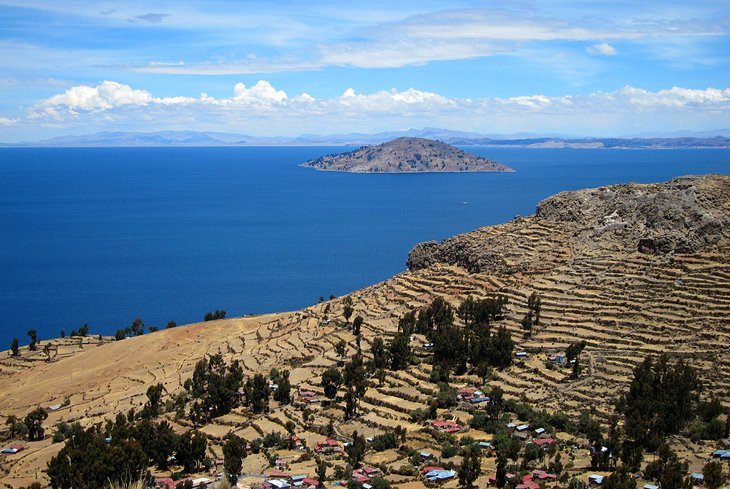 Lake Titicaca – Boat on the water with Isla Amantani in the background
Lake Titicaca – Boat on the water with Isla Amantani in the background
According to the Lake Titicaca Binational Autonomous Authority, the lake supports over 530 aquatic species and is a vital ecosystem in the region. Let SIXT.VN arrange your transport to Puno and coordinate boat tours, allowing you to witness the cultural richness and natural beauty of Lake Titicaca firsthand.
5. Gazing into Colca Canyon: A Natural Wonder
How deep is the Colca Canyon? Colca Canyon reaches a depth of 3,400 meters, making it twice as deep as the Grand Canyon. Although it was once thought to be the deepest canyon in the world, Colca Canyon (Cañon del Colca), twice as deep as the Grand Canyon, is the second deepest after nearby Cotahuasi Canyon. The canyon reaches a depth of 3,400 meters and is the result of a seismic fault between two volcanoes. At the base far below is a winding river.
The Colca Canyon area has been inhabited for thousands of years and was home to the Collagua, Cabana, and eventually the Inca peoples. Stone terracing along the canyon walls dates to AD 800 and is still in use today.
The canyon is about a four-hour drive from Arequipa. Day trips to the canyon are available from Arequipa but two or more days are recommended considering the driving time involved in accessing the canyon. Besides gazing out at the canyon, there are also hot springs, churches, villages, and Inca ruins to explore. Condors are also a big attraction in Colca Canyon as they soar past the cliff walls.
 Colca Canyon – View of the canyon landscape
Colca Canyon – View of the canyon landscape
According to the Colca Canyon Tourism Management, the canyon is home to the Andean Condor, with a wingspan of up to 3 meters, making it a prime location for birdwatching. With SIXT.VN, plan your trip from Arequipa to Colca Canyon, ensuring a comfortable and scenic journey to witness the grandeur of this natural wonder and its majestic condors.
6. Unraveling the Nazca Lines: Ancient Mysteries from Above
What is the mystery behind the Nazca Lines? The mystery behind the Nazca Lines lies in their creation, purpose, and the civilization that produced them. The mysterious Nazca lines are an unusual sight that will leave you with a sense of awe. These huge images on the desert floor were relatively undiscovered until planes flying over the area in the 1920s saw the lines from the air and realized they formed distinct patterns and images.
Until that time there was some recognition of the hillside drawings near Nazca and Paracas, which can be seen from ground level. However, the huge drawings on the flat desert floor are so large that it requires an aerial view to be appreciated.
From the air, it is possible to see 70 different plant and animal drawings as well as hundreds of lines and other geometrical shapes. Some of these lines stretch as long as 10 kilometers, and they are spread over hundreds of square kilometers. Most notable among the figures are a lizard measuring 180 meters long, a condor with a 130-meter wingspan, and several others that include a monkey, hummingbird, killer whale, and spider.
Although it is not known exactly who created the lines or how and why, theories hold that the lines were the product of the Paracas and Nazca cultures sometime between 900 BC and AD 600. Why they were created is the subject of much debate. Some of the theories put forward suggest the lines were a type of astronomical calendar for agriculture, an alien landing pad, a running track, walkways joining ceremonial sites, or part of a water cult.
The lines were created by removing the dark surface layer of stones and piling them at the sides of the lines, creating a contrast between the dark stones and the exposed lighter soil below. Flights can be booked in advance or on a walk-in, first-come first-serve basis.
Approximately four kilometers outside of Nazca are the Cantalloc Aqueducts. Built around AD 300 to 600, the aqueducts were designed to provide a year-round water source for the area. They conduct water from the mountain springs down to Nazca by means of underground canals. Some of the Cantalloc Aqueducts are still used by farmers in the area.
Also of interest in the area is the Cemetery of Chauchilla, which contains Nazca remains and mummies.
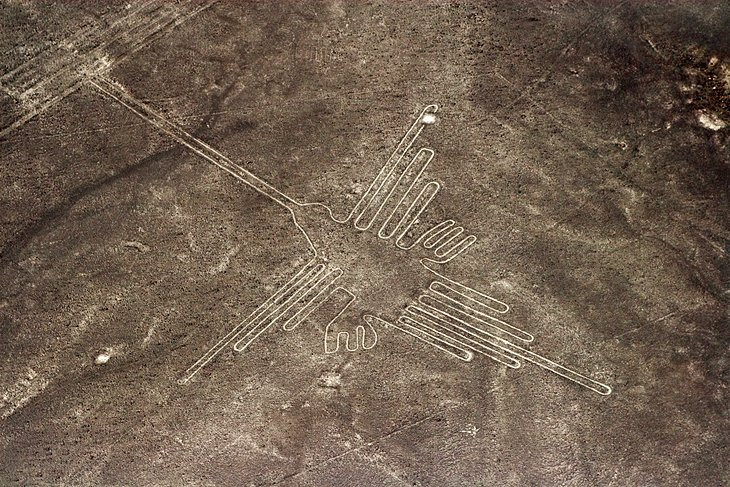 Nazca Lines – Hummingbird figure
Nazca Lines – Hummingbird figure
According to the Instituto Nacional de Cultura del Perú, the Nazca Lines were declared a UNESCO World Heritage Site in 1994, highlighting their cultural and historical significance. With SIXT.VN, book your transportation and aerial tour over the Nazca Lines, ensuring a comprehensive and awe-inspiring experience of these ancient geoglyphs.
7. Discovering the Sacred Valley: Inca Heartland
What is the Sacred Valley known for? The Sacred Valley is known for its fertile land, Inca ruins, and picturesque towns. Less than an hour’s drive north of Cusco is the beautiful Sacred Valley and the towns of Pisac, Urubamba, and Ollantaytambo. This fertile valley has many Inca ruins worth exploring but is also a peaceful area to spend some time wandering through markets or soaking up local culture.
Among the highlights in the valley are the Pisac Ruins and the Sunday Market in Pisac (smaller market days are held on Tuesdays and Thursdays). Here, you’ll find an amazing selection of local handicrafts.
A little out of the way but worth the trip is the town of Moray with circular terracing used as an agricultural testing area by the Incas. You’ve probably seen photos of the perfectly circular terraces on social media sites and other tourist sites.
Researchers feel that this innovative style of farming was the Inca’s version of a greenhouse. Different levels and different areas had warmer or cooler temperatures along with more or less sun. Moray is located near the small village of Maras and is at a gasp-inducing elevation of 11,500 feet.
While visiting Moray, be sure to stop in and see the salt mines at Salinas. These fascinating mines have been in use since the time of the Incas. The Salinas mines produce a sought-after pink color salt along with traditional white salt.
The intricate set up of the salt mines is the main attraction here. The high-saline-content water emerges from a spring at the top of the mine and is routed through a complex set of canals through square evaporation ponds.
An ideal place to snap a photo is from the top of the salt ponds, where you’ll have the white salt ponds juxtaposed against the backdrop of the green valley in the distance.
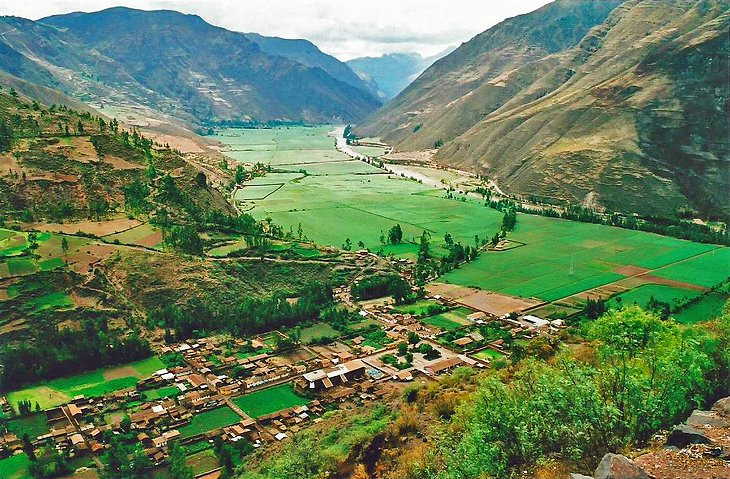 Sacred Valley – Terraced landscape
Sacred Valley – Terraced landscape
According to the Ministry of Agriculture and Irrigation of Peru, the Sacred Valley is a vital agricultural region, known for its production of maize and other crops. Let SIXT.VN provide comfortable transportation throughout the Sacred Valley, allowing you to explore the Inca ruins, bustling markets, and unique agricultural sites at your own pace.
8. Exploring Ollantaytambo: A Living Inca Town
Why is Ollantaytambo important? Ollantaytambo is important because it is one of the best-preserved Inca towns and a significant archaeological site. The ruins and fortress at the beautiful little town of Ollantaytambo should be on your list of places to see when visiting the Sacred Valley. The town is very walkable and fun to explore. Like Pisac, it’s home to an excellent assortment of vendors selling handmade handicrafts.
It’s a photogenic spot with two imposing Inca ruins towering over the village. Take a bit of time to wander up the hill and explore the ruins. Highlights include the impressive Wall of the Six Monoliths and the Bath of the Princess. Nearby are the Terraces of Pumatillis and the Pinkuylluna, an ancient storehouse.
 Ollantaytambo – Inca ruins
Ollantaytambo – Inca ruins
According to archaeological studies, Ollantaytambo served as both a fortress and a religious center during the Inca Empire. With SIXT.VN, plan your visit to Ollantaytambo, ensuring a seamless and informative exploration of this historic town and its impressive Inca ruins.
9. Visiting Arequipa’s Historical City Center: The White City
What is Arequipa known for? Arequipa is known for its beautiful architecture made of white volcanic stone and its stunning mountain backdrop. Arequipa, at more than 2,300 meters, is often regarded as Peru’s most beautiful city. Set against a backdrop of snow-capped mountains, the city center is a designated UNESCO World Heritage Site. Arequipa’s main claim to fame is the old architecture constructed of sillar stone, a volcanic rock that radiates a bright color in the sunlight. Most of the colonial buildings in the historic city center are made from this stone, giving rise to its nickname of the “white city.”
Arequipa is also often a stopping-off point for those looking to visit the Colca Canyon (Cañon del Colca), which is about a four hour’s drive from the city.
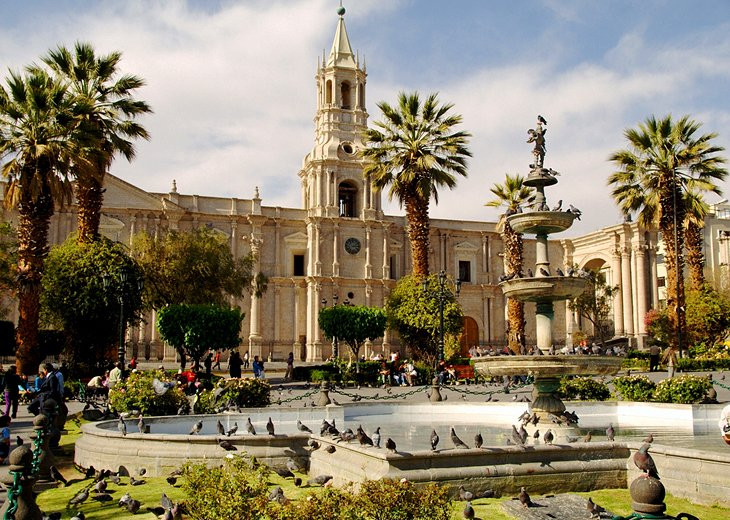 Arequipa – Historical city center
Arequipa – Historical city center
According to UNESCO, Arequipa’s historical center was recognized as a World Heritage Site in 2000, acknowledging its unique architectural style and historical significance. With SIXT.VN, discover Arequipa’s historical city center with ease, utilizing our reliable transportation services to explore the stunning colonial architecture and vibrant cultural scene.
10. Venturing into Puerto Maldonado and the Amazon: A Jungle Adventure
What can you see in Puerto Maldonado? You can see diverse wildlife such as caimans, monkeys, and parrots in Puerto Maldonado. Just a half hour flight from Cusco, Puerto Maldonado is a key jumping-off point for tours of the Amazon. This is a completely different experience than what you will find in other parts of Peru, with hot humid jungle and a chance to see all kinds of unique wildlife. Caimans, capybara, monkeys, parrots, turtles, and piranhas are what you can expect to find in this part of the country.
The Reserva Nacional Tambopata and the Parque Nacional Bahuaja Sonene are the two main attractions, and they are well serviced by a number of jungle lodges. The Reserva Nacional Tambopata jungle lodges are approximately a one-hour boat ride from Puerto Maldonado. Parque Nacional Bahuaja Sonene is across the river from the Parque Nacional Madidi in Bolivia and takes about four hours to reach by boat. Tours typically range from a couple of days to week-long adventures.
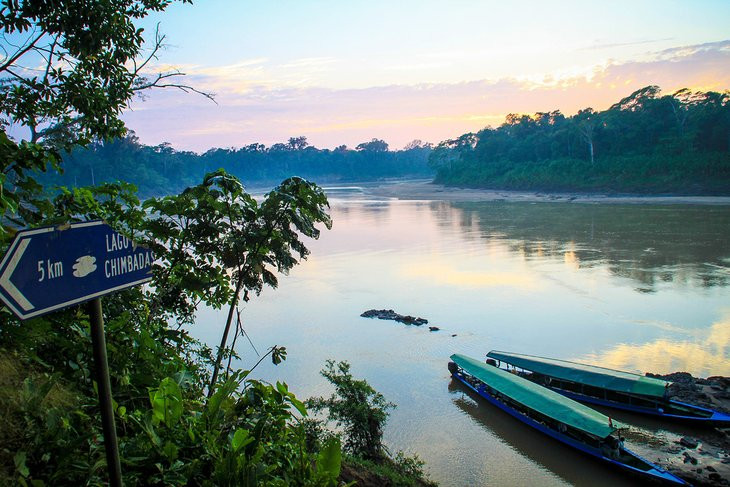 Amazon River – River at Puerto Maldonado
Amazon River – River at Puerto Maldonado
According to the Servicio Nacional de Áreas Naturales Protegidas por el Estado (SERNANP), the Tambopata National Reserve is one of the most biodiverse areas on Earth, with over 600 bird species and numerous mammals and reptiles. Let SIXT.VN organize your travel to Puerto Maldonado and arrange your jungle tours, ensuring a safe and immersive experience in the heart of the Amazon rainforest.
11. Strolling Through Lima’s Historic Center: A UNESCO Site
What is Lima famous for? Lima is famous for its historical center, delicious cuisine, and vibrant culture. Lima’s Historic Center is a UNESCO World Heritage Site. The city was founded in the 1500s and, although many of the original structures were destroyed, it still holds significant historical value and is a beautiful place to wander around.
One of the most pleasant places to visit in Lima is the main square, Plaza de Armas (Plaza Mayor), in the heart of the city’s historic district. A majority of the structures were rebuilt following the devastating earthquake of 1746. The highlights around the Plaza de Armas are the cathedral on the east side and Government Palace (Palacio del Gobierno) on the north side. Also of interest are the Archbishop’s Palace and the Casa del Oidor.
Leading off the square is the pedestrian street, Jiron de la Union, with shops, restaurants, and the historic Iglesia de La Merced.
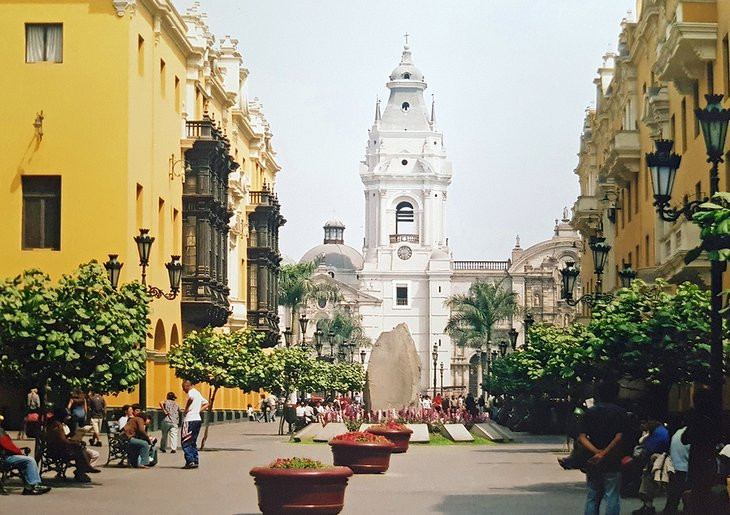 Lima – Historical center
Lima – Historical center
According to UNESCO, Lima’s historic center was designated a World Heritage Site in 1988, recognizing its historical significance as the former capital of the Spanish Viceroyalty. With SIXT.VN, enjoy a guided tour of Lima’s historic center, with seamless transport to explore the city’s stunning architecture, vibrant culture, and historical landmarks.
12. Riding Dunes in Ica and Huacachina: Desert Oasis
What is Huacachina known for? Huacachina is known for its oasis setting, sand dunes, and adventure activities like sandboarding. For the sporting type looking to try something a little different, the oasis resort of Huacachina on the outskirts of Ica has just the answer. This picture-perfect, palm-fringed resort town just west of Ica is situated around a lagoon surrounded by huge sand dunes, some of which reach 1,000 meters in height.
People come here to try out the sport of sandboarding. Similar to snowboarding, sandboarding involves surfing down the sand dunes on specially made sand-boards, which can be rented in the area. For the less coordinated, renting dune buggies is another great way to get out and enjoy the landscape.
Ica is slightly higher than the ocean and consequently is not affected by the usual coastal mist like other towns along this stretch. The town has a year-round sunny and dry climate, making it a good place to visit at any time.
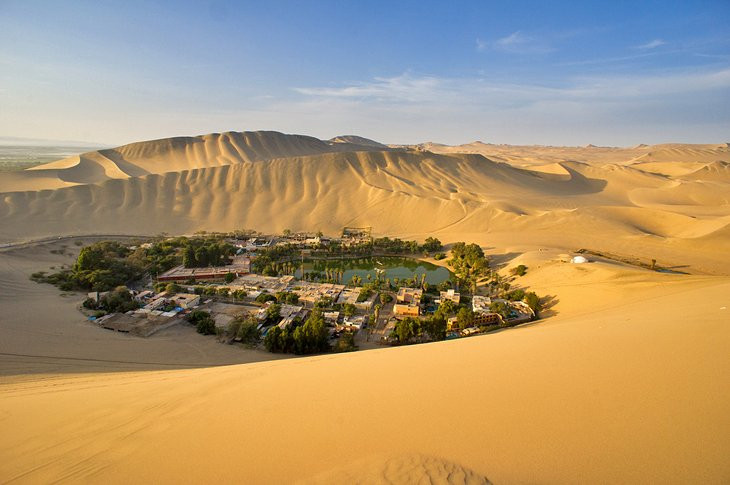 Ica and Huacachina – Sand dunes
Ica and Huacachina – Sand dunes
According to local tourism boards, Huacachina’s sand dunes are among the highest in the world, providing an exhilarating experience for sandboarding enthusiasts. With SIXT.VN, plan your desert adventure to Ica and Huacachina, with seamless transportation to experience the thrill of sandboarding and the beauty of this desert oasis.
13. Exploring Pisco and the Ballestas Islands: Wildlife Paradise
What animals live on the Ballestas Islands? Animals that live on the Ballestas Islands include sea lions, penguins, and various seabirds. The main reason to come to Pisco, about 200 kilometers south of Lima, is to see the nearby Islas Ballestas and the Reserva Nacional de Paracas on the Paracas Peninsula. Almost directly west of Pisco, the Islas Ballestas, sometimes referred to as the “poor man’s Galapagos,” are home to hundreds of thousands of birds, large colonies of sea lions, pelicans, penguins, and dolphins.
Boat tours from Paracas and Pisco, which visit the islands daily, leave in the morning. The full tour takes you past the “Candelabra,” a hillside geoglyph seen from the coast, and then spends a considerable amount of time boating around the islands watching for wildlife. This tour is generally a half-day trip, returning around noon.
The Paracas Peninsula, jutting out into the Pacific Ocean just south of Pisco, is home to the Reserva Nacional Paracas and the largest section of protected coastline in Peru. The shoreline of the Paracas Peninsula supports a huge variety of wildlife, with approximately 200 species of seabirds, two types of sea lions, a rare type of otter, and the endangered Humboldt penguins.
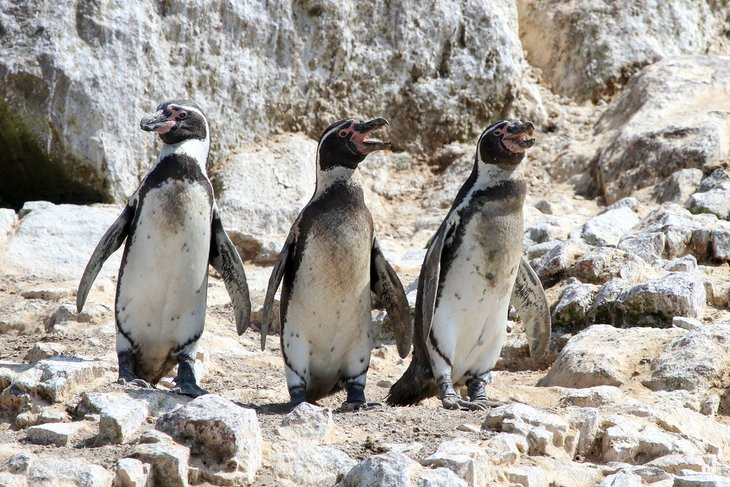 Ballestas Islands – Penguins
Ballestas Islands – Penguins
According to SERNANP, the Ballestas Islands are home to over 1.5 million seabirds and thousands of marine mammals, making it a vital ecosystem for wildlife. With SIXT.VN, arrange your visit to Pisco and the Ballestas Islands, with seamless transportation and boat tours to witness the incredible biodiversity of this coastal paradise.
14. Discovering Sillustani: Ancient Burial Towers
What are chullpas? Chullpas are funerary towers built by the Colla people to bury their nobility. Sillustani, outside the city of Puno and not far from Lake Titicaca, is the site of some of the area’s most impressive funerary towers (chullpas). Standing as high as 12 meters, these structures were built by the Colla people around AD 600 to bury their nobility. Entire families, along with food and personal possessions, were buried in these cylinders.
Most of the towers are set in a scenic area along the bank of Lake Umayo, just walk up a hill from the parking lot to the plateau above. The towers stand at the far end of the field with the lake behind. Below the parking lot is a small marshy lake where locals can be seen poling along in their boats, harvesting reeds.
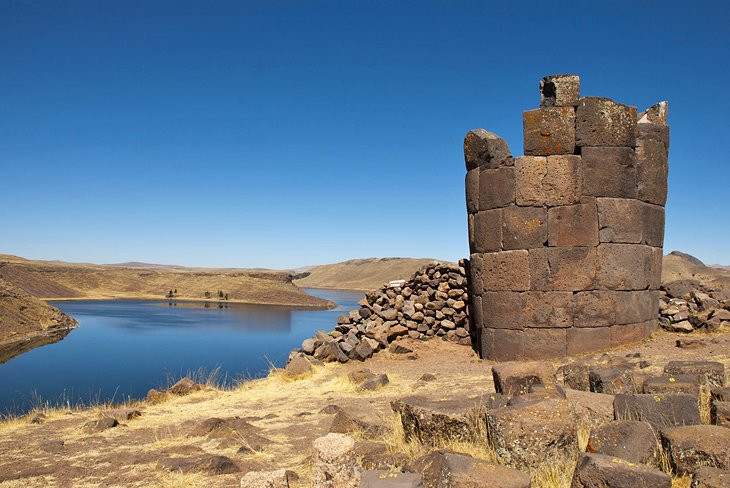 Sillustani – Funerary tower
Sillustani – Funerary tower
According to archaeological studies, the funerary towers at Sillustani reflect the advanced architectural and engineering skills of the Colla culture. Let SIXT.VN arrange your transportation to Sillustani, allowing you to explore these ancient burial towers and learn about the fascinating history of the Colla people.
15. Wandering Through Barranco: Lima’s Bohemian District
What is Barranco known for? Barranco is known for its bohemian atmosphere, colorful architecture, and ocean views. The quaint hillside district of Barranco, just south of Central Lima and Miraflores, is a charming area within easy commuting distance of downtown Lima. With unassuming colorful colonial architecture lining the narrow streets and hillside ocean views, the area offers a much more relaxed pace than the city.
The area has long been popular with artists and poets, giving it a Bohemian feel. This is a great place to wander in the afternoon or enjoy a meal, particularly at sunset, at one of the restaurants overlooking the ocean. Besides the atmosphere, the one main tourist attraction in Barranco is the Puente de Los Suspiros (Bridge of Sighs).
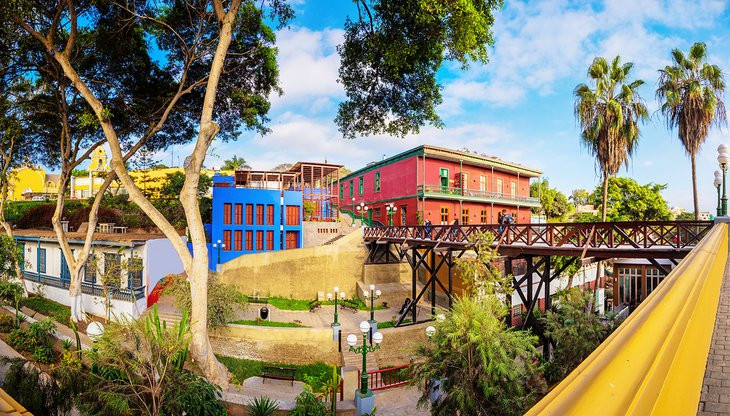 Barranco – Bridges
Barranco – Bridges
According to the Municipality of Barranco, the district is a hub for artists and cultural events, attracting visitors with its unique atmosphere and historical charm. With SIXT.VN, enjoy seamless transportation to Barranco, where you can stroll through the colorful streets, admire the ocean views, and immerse yourself in the district’s bohemian culture.
16. Exploring the Cordillera Blanca: A Mountain Paradise
What is Cordillera Blanca known for? Cordillera Blanca is known for its stunning mountain peaks, glaciers, and hiking trails. A stunning area of mountains and valleys, the Cordillera Blanca draws mountain climbers, hikers, and outdoor enthusiasts from around the world. The Cordillera Blanca is home to Peru’s highest peak, Huascaran. Also located in the same area of the Andes are sixteen other mountains over 6,000 meters in height.
Getting here takes a bit of work, and you need to be well prepared if you are planning an excursion into the heart of this region. The weather is extremely changeable; it can be snowing one minute and then blazing hot the next.
Some of the most notable treks include the Santa Cruz, the Alpamayo, and the Rurec Shaqsha. The best time to visit is from April through to October.
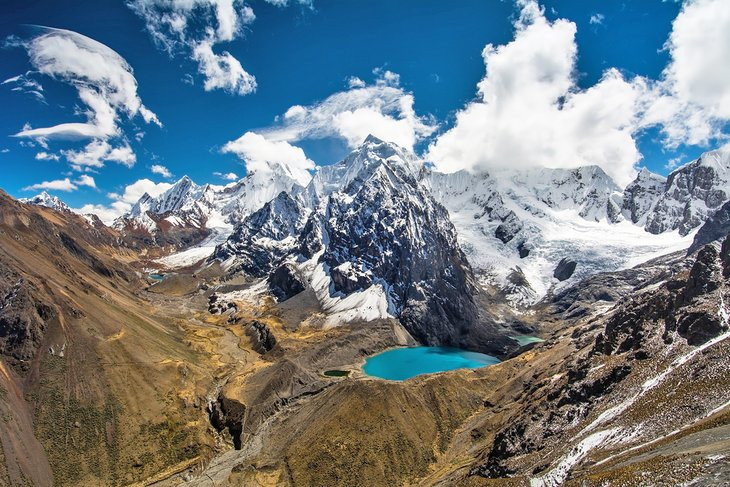 Cordillera Blanca – Mountain range
Cordillera Blanca – Mountain range
According to SERNANP, the Huascarán National Park in the Cordillera Blanca is a UNESCO World Heritage Site, protecting a unique ecosystem of high-altitude flora and fauna. With SIXT.VN, plan your adventure to the Cordillera Blanca, ensuring you have the necessary transportation and local guides to explore the stunning mountain peaks and glaciers safely.
17. Visiting Saqsaywaman: Inca Fortress Above Cusco
What is Saqsaywaman known for? Saqsaywaman is known for its massive stone walls and intricate Inca construction. If you are staying in Cusco, an afternoon or day trip to nearby Saqsaywaman is definitely in order. This site with its towering monoliths of rock is located high above the city at a gasp-inducing altitude of 3,701 meters (12,142 feet).
The site is notable for the massive blocks that have been intricately fitted together without the use of mortar. It’s due to this incredible feat of engineering that the fortress walls have been able to survive devastating earthquakes that have destroyed parts of nearby Cusco.
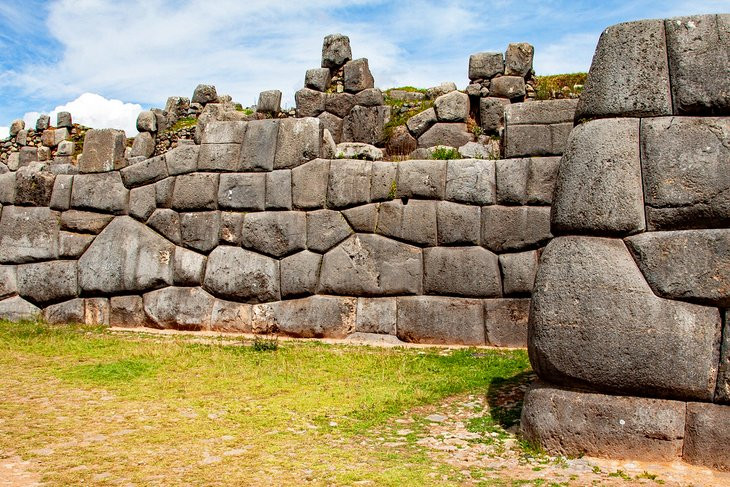 Saqsaywaman – Inca stonework
Saqsaywaman – Inca stonework
According to archaeological research, Saqsaywaman served as a ceremonial center and a defensive fortress during the Inca Empire. Let SIXT.VN provide transportation to Saqsaywaman, allowing you to explore this impressive Inca fortress and learn about its historical significance.
18. Hiking Salcantay: A Trek to Machu Picchu
What is the Salcantay Trek? The Salcantay Trek is a challenging alternative trek to Machu Picchu, known for its stunning mountain scenery. The spectacular mountain peak known as Salcantay is fast becoming a “go-to” hiking destination in Peru. Towering above the surrounding landscapes, the 20,574-foot-high peak is jaw-droppingly beautiful but fortunately not overrun with visitors.
The easiest way to see Salcantay is hike the Salcantay Trail – a 37-mile (60-kilometer) trek that ends at Machu Picchu. Along the way, you’ll ascend to 15,190 feet (4,630 meters) above sea level at your highest point, an elevation sure to take your breath away. Don’t despair, you can soothe all your sore muscles in the hot springs in Cocalmayo along the way.
 Salcantay – Humantay Lake
Salcantay – Humantay Lake
According to the local trekking agencies, the Salcantay Trek offers a diverse range of landscapes, from snow-capped mountains to lush cloud forests, making it a unique and unforgettable experience. With SIXT.VN, plan your Salcantay trek with reliable transportation to the trailhead, ensuring a safe and rewarding journey to Machu Picchu.
5 Intentions for Searching “Peru Tourism and Attractions”
Here are five key intentions users might have when searching for “Peru Tourism and Attractions”:
- Planning a Trip: Users are in the early stages of planning a trip to Peru and want to discover the best places to visit and things to do.
- Seeking Inspiration: Users are looking for inspiration for their next vacation and want to see visually appealing content about Peru’s top attractions.
- Comparing Destinations: Users are comparing Peru to other travel destinations and want to understand what makes Peru unique and worth visiting.
- Finding Local Tours and Services: Users are looking for local tour operators and service providers to help them plan and execute their trip.
- Understanding Travel Requirements: Users want to know about visa requirements, health precautions, and other practical information for traveling to Peru.
Why Choose SIXT.VN for Your Peru Adventure?
Planning a trip to Peru can be overwhelming, but SIXT.VN is here to make your journey seamless and unforgettable. We understand the challenges travelers face, from language barriers to navigating unfamiliar transportation systems. That’s why we offer a comprehensive suite of services designed to cater to your every need:
- Personalized Travel Consulting: Our expert travel consultants will work with you to create a customized itinerary that matches your interests and budget, ensuring you don’t miss any must-see attractions.
- Safe and Convenient Airport Transfers: Arrive in Peru with peace of mind knowing that a reliable SIXT.VN driver will be waiting to whisk you away to your hotel.
- Handpicked Hotel Selection: We partner with a wide range of hotels to offer you the best accommodations options, whether you’re looking for a luxury resort or a cozy guesthouse.
- Curated Tours and Activities: We offer a variety of professionally guided tours that allow you to explore Peru’s iconic landmarks and hidden gems with ease.
- Hassle-Free Flight Bookings: Let us take care of your flight arrangements, ensuring you get the best prices and convenient travel schedules.
With SIXT.VN, you can relax and enjoy your Peru adventure, knowing that every detail is taken care of. Our commitment to convenience, reliability, and exceptional service sets us apart, making us the perfect partner for your journey.
FAQ about Peru Tourism and Attractions
- What is the best time to visit Peru?
The best time to visit Peru is during the dry season, from May to September, when there is less rainfall and the weather is ideal for hiking and outdoor activities. - Do I need a visa to enter Peru?
Visa requirements depend on your nationality. Citizens of many countries, including the United States, Canada, and the European Union, do not need a visa for tourism purposes for stays up to 90 days. - What is the currency used in Peru?
The currency used in Peru is the Peruvian Sol (PEN). - What are some essential things to pack for a trip to Peru?
Essential items to pack include comfortable hiking shoes, layers of clothing, sunscreen, insect repellent, a hat, and any necessary medications. - Is it safe to drink tap water in Peru?
It is not recommended to drink tap water in Peru. Bottled water is readily available and should be used for drinking and brushing your teeth. - What is the altitude in Cusco, and how can I prevent altitude sickness?
Cusco is located at an altitude of 3,400 meters (11,200 feet). To prevent altitude sickness, acclimatize gradually, drink plenty of water, avoid alcohol and heavy meals, and consider taking altitude sickness medication. - What are some popular Peruvian dishes I should try?
Popular Peruvian dishes include ceviche (marinated raw fish), lomo saltado (stir-fried beef), and ají de gallina (creamy chicken stew). - What languages are spoken in Peru?
The official languages of Peru are Spanish and Quechua. - How can I get around in Peru?
You can get around in Peru by bus, train, plane, or taxi. SIXT.VN offers reliable transportation services for seamless travel throughout the country. - Are there any cultural etiquette tips I should be aware of when visiting Peru?
Cultural etiquette tips include being respectful of local customs, asking for permission before taking photos, and being mindful of noise levels in residential areas.
Ready to Explore Peru?
Don’t let the challenges of planning a trip to Peru hold you back. With SIXT.VN, you can embark on an unforgettable adventure with confidence.
Contact us today to learn more about our Peru travel packages and let us help you create the trip of a lifetime!
Address: 260 Cau Giay, Hanoi, Vietnam
Hotline/Whatsapp: +84 986 244 358
Website: SIXT.VN



